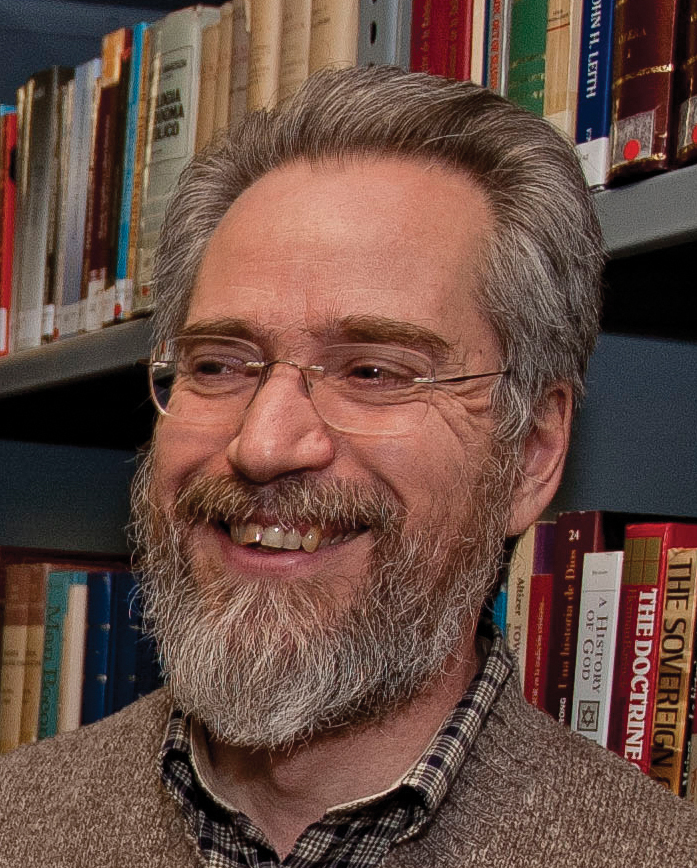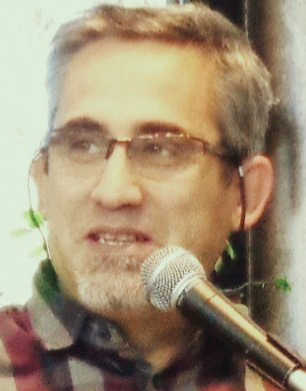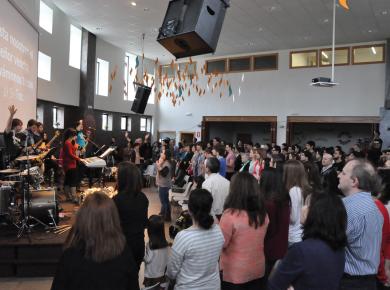Posted: May 19, 2016
Christianity is experiencing rapid decline in Europe. We have gone in the past two or three generations from being an outwardly Christian culture, to something post-Christian. In general, statistics from Mennonite World Conference indicate that the evolution of the old Mennonite churches in Europe reflect this same tendency.
One exception is the case of Spain, where in under forty years a new reality has come into being: a flourishing Anabaptist presence. We see this growth as a sovereign work of the Spirit that surpasses our own inadequate efforts.
Our brothers and sisters in the old European Mennonite churches (those that originated in the sixteenth century) tell us that they find our reality encouraging and hopeful. We, on the other hand, value their centuries of faithfulness and feel honored when they keep us in mind for continent-wide activities and organizations.
History
The first documented activity of Mennonites in Spain occurred during the Spanish Civil War (1936-1939), when Mennonite Relief Committee sent several volunteers from the United States to participate in a program to feed child war refugees. The victory by the fascists faction, of National-Catholic ideology, effectively terminated Mennonite involvement in Spain at the end of the war.
During the 1970s, it became possible to send missionaries to Spain. After consulting with leaders of the Spanish Protestant churches, Mennonite missionaries initially decided to cooperate with them instead of establishing yet another denomination in the country. The first missionaries, John and Bonnie Driver, were well received for the freshness of their deeply biblical message, with Anabaptist emphases that many young Evangelicals found especially exciting. The Drivers remained in Spain for 10-15 years, before returning to South America, where they climaxed a long missionary career.
Meanwhile, the first Mennonite Church had come into being in Barcelona. The group that initiated it arrived from Brussels, Belgium, where they had migrated years before and where they had been worshiping with a Mennonite congregation at an American mission. José Luis Suárez gave initial leadership to this group, and was their pastor for many years until his retirement.
Also during the 1970s an interesting development occurred in the city of Burgos. There, a movement of conversions among teenagers was taking place within the Catholic Church. With a strong component of music and the arts, plus communal life in shared households, this movement shook the whole city. John Driver was one of the many people they invited to speak in Burgos, and his approach to the teaching of Jesus caught the imagination of these young Christians.
When three “elders” of the movement made a trip to the United States to visit radical Christian communities, they met Dionisio and Connie Byler of Argentina. They invited the Bylers to come to Burgos to continue the teaching ministry they had received from Driver. The Bylers have remained in Burgos since 1981, with the support of Mennonite Mission Network. In the mid-1990s, the group that started out as Catholic adopted a Mennonite identity.
North American Brethren in Christ (BIC) missionaries Bruce and Merly Bundy arrived in Madrid in the 1990s, inaugurating another era of Anabaptist influence in the country. Through their efforts and the efforts of others, the BIC now have two churches in the Madrid area. More recently, Juan and Lucy Ferreira from Venezuela began a BIC work in Tenerife, in the Canary Islands, which relates to the BIC churches of Madrid.
Another effort developed early in the present century, when Organización Cristiana Amor Viviente – a MWC member church in Honduras – sent Antonio and Irma Montes to Spain to lead a missions effort. The fruits of their work include two churches in Catalonia and a small group in Madrid.
Get-togethers and associations
Since the 1980s these different groups in Spain – widely dispersed in cities that are far from each other – have made a point of getting to know each other and of cultivating jointly an Anabaptist or Mennonite identity. Since 1992, this relationship has been rooted in Encuentros Menonitas Españoles (EME – Spanish Mennonite Get-Togethers), which are held every two years.
After a few years we organized as a fraternal association, called Anabautistas, Menonitas y Hermanos en Cristo – España (AMyHCE). As AMyHCE we participate in FEREDE, the association of Spanish Protestant churches (where we are known as one of the “denominational families” of Spanish Protestantism), and also in Mennonite World Conference. In MWC we are rather unique in having all of our churches, with their various connections with the historic Anabaptist denominations, participate jointly under this single representation.
Finally, our Anabaptist/Mennonite identity has been strengthened through fraternization with old European Mennonite churches. In 2006, for instance, the European Mennonite Conference (MERK) was held in Barcelona, bringing together Mennonites from across the European continent for encouragement and discussion.
Outstanding characteristics
As this brief history indicates, one of the features of AMyHCE is our great diversity – diversity of connectedness to the different denominations of world Anabaptism, but also diversity of emphasis and practice, in spite of being small. For instance, in our communities it is possible to find typically Pentecostal practices, but also misgivings regarding emotionalism. Theologically, there are among us both Fundamentalist and Liberal tendencies, but neither are we lacking in an Anabaptist “third way,” which explores alternative ways of explaining Christian faith.
Though few in numbers, our churches have not neglected service and missions. For years the congregation in Burgos was known for its center for rehabilitation of drug addicts, while the congregation in Barcelona operated homes for the elderly and the mentally handicapped. The Burgos church has established a home for children in the African nation of Benin, and a ministry with ex-child soldiers in Ivory Coast. This ministry in Africa is blessed by the support of other churches and individuals.
Since our beginnings in the 1970s, there has been among us an important element of biblical and theological exploration in a Mennonite or Anabaptist mode, which finds expression in ministries of teaching and literature, in print and in the Internet. And since 2010, Dr. Antonio González – pastor of one of the BIC congregations – has worked with other Anabaptists in leading a small center for theological studies, Centro Teológico Koinonía (CTK, or Koinonia Theological Centre), which seeks to train a new generation of leaders.
Some other clearly Anabaptist emphases surface repeatedly in our communities:
- The church as a close-knit, closely bonded family that practices mutual assistance.
- Jesus as Teacher and example, as well as Savior and Lord
- Nonviolence and objection to military service
- A pragmatic – rather than dogmatic – theology: more interested in personally following Jesus than in theoretic affirmations about doctrine
Looking ahead
Some significant challenges face this new growth of Anabaptist/Mennonite Christianity in Spain. In the next 10-15 years, most of our churches will face a significant generational relay in leadership. New leadership will arise, or else be imported from other churches. Will this second-generation leadership have a clear sense of identity beyond generic, Evangelical Christian identity? The creation of the CTK school hopes to contribute to the shape of the answer to that, but only the passing of time will truly answer the question.
Additionally, Protestant Christianity in general, and Anabaptist/Mennonite Christianity as a form of non-Catholic Christianity, are relatively new arrivals in Spain. They have arrived, not coincidentally, in precisely the generation in which the Spanish people began to reconsider the ancient connection between Spanish identity and Roman Catholic religion. But the weakening hold of Catholicism over the Spanish people does not necessarily mean openness to other forms of Christianity. Rather, it is a sign of a Europe-wide trend to a post-Christian, profoundly atheistic way of understanding human existence. Superstition and silly credulity are on the rise.
The prevalent culture is not necessarily hostile to Christianity, but it does find Christianity utterly uninteresting, perhaps embarrassingly primitive. The challenge for our churches – and sister churches of every other stripe – is to find a way to light the flame of interest, curiosity and commitment. Essentially, this constitutes a call for a church that overflows with the life and presence of the Spirit of God.
We have no illusion of being able to kindle the flame of interest, conviction and passion for Christ, with our own witness or human resources. But we are of course committing our energies and resources to this end anyway. We do not live under the illusion that the fact of prayer generates a mechanically automatic response from God. Yet we redouble our commitment to prayer, beseeching God on our knees to pour out God´s Spirit upon this country.

In the final analysis, this youngest shoot of Anabaptist/Mennonite Christianity in Europe shares with our older sister-churches of Anabaptist origins the reality that our very survival – not to mention propagation – depends most absolutely on the grace of God. Only the grace of God can grant us a future.
Paradoxically, this is precisely the reason for our hope and confidence and faith for a future for our churches.
Dionisio Byler is a writer and a teacher at the Protestant Faculty of Theology in El Escorial, near Madrid. He has been secretary of AMyHCE since its creation.
On Being Anabaptist in Spain
 Agustín Melguizo
Agustín MelguizoSome of the demands of Anabaptism have been accepted by most of the Evangelical churches which I relate to: for instance, separation of church and state and adult baptism. This implies [we are] living alongside of and in cooperation with different Christian churches, with which we have some differences, but also much in common.
It also means [we need] to look at our environment in order to take the light of Jesus to anyone who is open to him and, with personal and community witness, present a conversion which involves all areas of life and also implies a lifelong discipleship.
 David Becerra
David BecerraI am Mennonite because one day I discovered that the message and life of Jesus implies a radical nonviolence. Reading the gospel this way led me to be a conscientious objector to military service.
I am Mennonite because one day the pastor of the Barcelona Mennonite Church knelt and unexpectedly washed my feet. This taught me the true measure of authority: to serve others (as a slave).

For me, to be Anabaptist in Spain is not a biographical coincidence, but rather an option. For a time, the Lord led me on a search for a true and radical model of Christianity. [Becoming Anabaptist] was not in the first place, then, a choice of a local church or of a denomination. My walk with the Lord (and without him) and my theological search led me to look for a closer connection with the community project which Jesus and the apostles sought.
Undoubtedly, many of today’s Christians can also lay claim to a return to our origins. However, in that return they tend to forget some aspects of the message of Jesus, such as pacifism and the community dimension of faith, which are for me essential even though they have been forgotten by the main currents of Western Christianity.

Join the Conversation on Social Media
FacebookTwitterInstagramFlickrYouTube